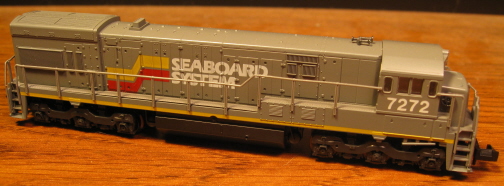
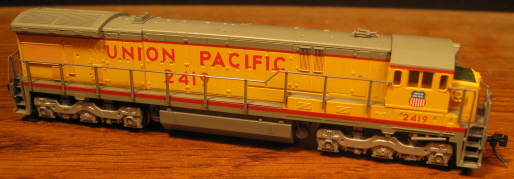


Introduced: 1989 (U30C), 1995 (C30-7), and 2011 (DCC-Ready U30C & C30-7)
These two models share identical internals (not to mention a similar evolution and history). So, to save myself a bit of time I'm going to cover them both here.
The production history of these two models is pretty head-scratching (and also pretty typical of Kato). The U30C was introduced in 1989 (and with a second/limited production run in 1991). And after that brief tease, it vanished for twenty years! Similarly, the C30-7 was run just once (in 1995), after which it vanished from Kato's lineup for sixteen years. Why, you ask? Well, I guess only Kato can answer that one.
Kato's groundbreaking 1989 U30C was the first N scale locomotive with a so-called "low friction drive", introducing to the world what I like to call the "Kato Glide". Kato's idea was to reduce current-collection friction in the trucks by mounting pointy-ended axles between two dimpled phosphor bronze wipers. Said wipers in turn transfer current to the split-frame chassis by contacting long phosphor bronze strips sandwiched between the fuel tank and the frame. This exact same scheme has been copied by just about every other manufacturer over the years, but nobody seems to be able to pull it off quite the way Kato does. Kato's large diesels are all just a bit smoother, quieter and "glidier" than everybody else's.
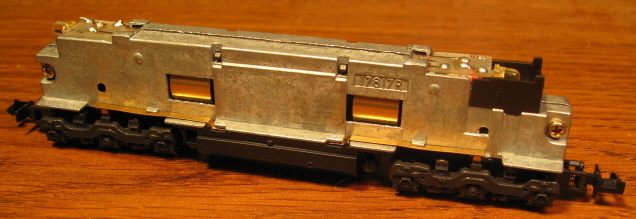
In addition to the low friction drive, the rest of the mechanism employs most of the other time-honored design features one normally associates with "modern" Kato diesels - IE, split-frame metal chassis, dual-flywheels, plastic truck assemblies, plastic gearing, blackened wheels, all-wheel drive, and all-wheel pick-up (no traction tires). The motor is an open-sided 5-poler. Directional lighting is provided by PC boards mounted on either end of the chassis. The couplers on the U30C are truck-mounted Rapidos (with open pilots), whereas the C30-7 has full pilots and shell-mounted Rapido couplers (a Kato innovation that first appeared on their 1991 SD40 model). Wheels are low-profile and have no problems on Code-55 track.
As alluded to above, performance is perfect in every way - smooth, quiet, flawless pickup and throttle response, exceptional pulling power, etc. About my only complaint is with the U30C's open pilots and truck-mounted Rapido couplers. Although at this stage of the game, most of these have long since been converted to Micro-Trains couplers (said conversion kit coming with full pilots and shell-mounted couplers). Oh, and I suppose one could grouse about the excessively high top-end speed. But, come on, that's just nit-picking.
Came 2011, and Kato finally re-released both models. The new shells are virtually identical to the original versions; the noteworthy new features for the U30C being full pilots and shell-mounted couplers. Additionally, both models now come with printed numberboards. The pilots also come with snowplow, anti-climber and MU hose details. The couplers are Kato's automatic/magnetic knuckle couplers.
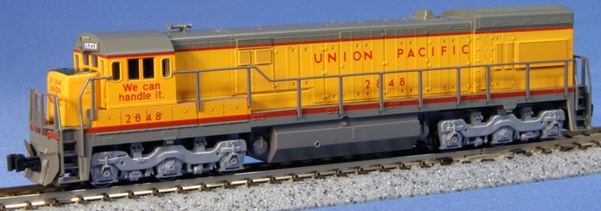
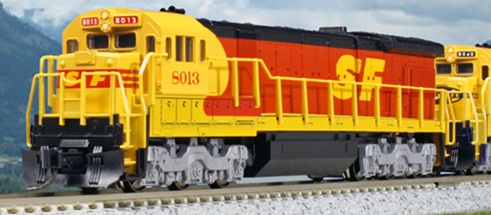
Internally, the chassis was redesigned to include full support for DCC - IE, it features a full-length lightboard with motor contacts (easily swapped out in favor of a drop-in decoder).

All the rest of the moving parts (trucks, gears, wipers, flywheels, etc) appear to be basically the same as on the original release. Shells can be swapped between the two versions, although the forward numberboard detail (with its arm of light-conducting plastic) is very different between the two versions, and as a consequence, a bit of a sticking point. Based on my experiments, the old numberboard part does not work with the new chassis (and vice versa). Consequently, I had to leave said numberboards with their original chasses when performing said shell swap. Also, the old shell has a raised section on the inside that tends to interfere with the lightboard on the new chassis. Sanding down said ridge definitely makes for a better fit.
The good news is that, performance-wise, nothing was lost in the redesign. This new DCC-Ready version runs every bit as well as the original 1989 and 1995 releases.
Trivia - although Kato also markets a so-called U23C, this is simply based on the roadname (Santa Fe) rather than any actual differences in the shell. IE, the shell is exactly the same as Kato's other U30C's (Kato justifies this by stating that the external differences between Santa Fe's U23C's and a U30C are "minor").
Removing the shells on these is beyond simple - grab the fuel tank with one hand and the shell with the other and it should slide up and off quite readily (just give it a bit of a wiggle).
Grade: A (all versions)
U30C Reviewed: 2/90 Model Railroader ("Kato's miniature U30C is the latest in a growing number of fine-running models that have excellent detail. This locomotive follows the firm's proven construction methods with minor variations to fit this particular unit... All of these U30Cs come ready to run with Rapido-type couplers. The U30C features an injection-molded styrene carbody with excellent detail. All the handrails are molded in a flexible engineering plastic to make them relatively indestructable... There are gaping holes where the pilots should be (due to the use of truck-mounted couplers)... The carbody snaps into place over the typical Kato split-frame mechanism. Its frame is made in two halves, which enclose the motor, brass flywheels, and worm gear system. All six axles are powered, and all the wheels pick up eletrical current. Our sample engines are among the smoothest units MR has tested in this scale. They started on a minimal amount of current and ran smoothly and steadily at the minimum speed. The top speed is quite high for a freight engine, but it does a fine job at more reasonable scale speeds. There are no traction tires, so the engine will slip if overloaded. As it comes, the Kato U30C produces sufficient drawbar pull to haul about 19 free-rolling cars. Our units had all the drivers blackened, and this finish seems to be a bit slippery... Once again Kato has come up with a good-looking road diesel that combines excellent detail with a superb running mechanism. Undec, SF, ATSF, BN, Chessie, D&H, PRR, Rock Island, Seaboard, SP, UP. $69.95")
C30-7 Reviewed: 4/95 Model Railroader ("Like previous Kato road switchers, this model's body is made in several pieces which snap together. The hoods and cab are are highly detailed injection-molded plastic castings fitted with clear window glazing, number boards, and headlight lenses. The handrails, stanchions, and walkways are molded in a tough engineering plastic. This flexible assembly snaps into recesses on top of the pilots and side sills to neatly conceal the thickness of the walkway molding that supports the handrails. The mechanism follows Kato's proven split-chassis design as used in the firm's earlier U30C. A pair of large metal castings enclose the motor and fill most of the space within the body. These two castings are electrically isolated from each other to carry both sides of the electrical circuit to the motor. Phosphor bronze wipers pick up track power from the back of each wheel and similar contacts pass it from the truck to the chassis. An open frame five-pole motor with a turned brass flywheel on each end powers the locomotive. Universal joints connect the motor to the worm shafts which rotate in rigidly mounted bearings. Idler gears engage the worms and transfer the rotation down into the respective trucks where spur gears drive each axle. Our sample had wheels with slightly oversize flanges and the back-to-back spacing was a bit narrow... The C30-7 started and ran smoothly throughout its speed range. The 2.1-volt starting point seemed a bit high for a Kato unit, but that dropped steadily as the model was run. The 1-ounce drawbar pull is sufficient to pull 24 cars on straight and level track. Its speed range is consistant with other Kato diesels, so it will fit right in with earlier U30Cs and SD40s. The C30-7 comes with Rapido-type couplers, but they're easy to change... The C30-7 is another superb model from Kato. Undec, ATSF, BN, Conrail, CSX, NS, UP. Price: $94.98")